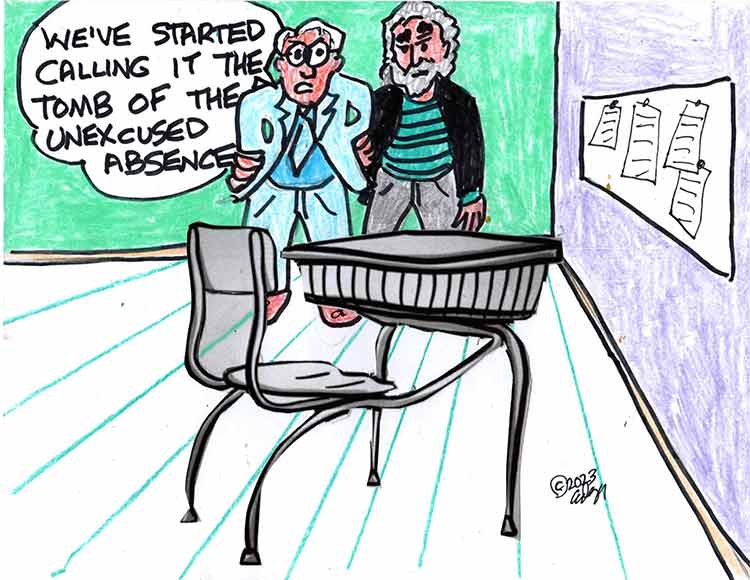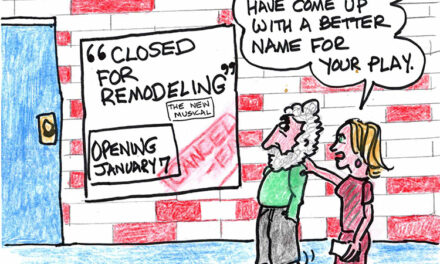Absence Makes the Mind Go Yonder
Where have all the students gone?
By Ed Goldman
This Fall we’ve been hearing the continued cry of school administrators and parents about the proliferation of unexcused student absences. To make their schools seem glamorous and inviting, some have resorted to swag (like backpacks, some filled with school supplies) and literally rolling out red carpets to welcome kids back from vacations—like Summer, certainly, but also those of the three-day persuasion.
It’s an issue I was involved with for a few years, but only professionally since my daughter, for the most part, seemed to like school in her younger years. We also weren’t the kinds of parents who’d yank her out of school on a moment’s notice because we were heading to our beach home. In those days, we had one—for eight years, in Capitola-By-The-Sea—but thought it was important for our kid to stay on schedule both academically and socially.
Is this school, or what?
I became aware of the problem during my consulting years with a company eventually called School Innovations & Achievement after a few other iterations. Based first in the city of Rancho Cordova then in the Sierra foothills, the firm reinvented itself a few times during my tenure, starting as a back-office firm to help schools process the overwhelming paperwork of state-mandated programs, and eventually becoming an innovative school software business.
One of its most successful products, Attention 2 Attendance, or A2A—which I named but had no hand in developing—continues to provide school principals with an automated tool for both tracking and dealing with unexcused absences and habitual truancy (which are kind of the same things). It was a multi-step process that alerted parents of their child’s unexcused absence from school, and in pretty short order morphed to phone calls from the school and ultimately a sit-down for the parents, principal and student.
SI&A’s clients—which consisted of several dozen California schools, as well as select ones in Texas—reported that even after the initial letter went out to parents, the attendance problem ebbed considerably, if not always vanished altogether. (The company was sold in the last two years but continues to have a robust presence. You can check it out at sia-us.com)
I enjoyed my time working with the founder, Jeff Williams, and his CFO/COO-C-Everything Susan Cook. But I always wanted to confess that until I’d become an adjunct professor/lecturer at colleges in Southern then Northern California, I hated hated hated going to school.
I hated elementary school (in New York City from kindergarten through second grade, and Lakewood, California from third through 12th grades). I hated going to class in college and I hated sitting around in graduate school seminars, especially courses in statistics. (As to the latter, I now gobble up data, especially as it applies to trends—like the rise of unexcused school absences, for example.)
While I had some very fine teachers along the way, I thought if I ever had the chance to stand in front of a classroom (and not just to read my theme on why it’s wrong to maltreat people and puppies), I’d try to not do everything that made me hate school.
But it was futile. No matter how “fun” I tried to make the journalism, public relations and broadcast classes I taught, there was still a curriculum that needed to be covered and grades that needed to be issued. I could skip the writing and administering of anxiety-inducing midterms and finals without fear of reprisal (academic freedom and all that) but not completely ignore the institutional requirements, including “office hours,” which were often just opportunities for lackluster students to suck up.
One young woman who hadn’t attended my newswriting class in five weeks finally showed up and said she’d been experiencing something called “koi trauma” (one of her exotic fish had died). “We were very close,” she blubbered.
A young man who took a class from me three semesters in a row always seemed to have a grandfather die just before a term paper was due.
I didn’t excuse these absences. But I also realized that, unlike K-12 classes, the information I was dispensing, whether received or not, wasn’t going to be of the life-altering variety that you get when you’re a kid. I remember that one of the studies we used at SI&A indicated that when kids missed classes as early as in first, second and third grade, it could impact not only the rest of their school careers but also their adult lives.
That happened to me. Because my Dad was a firefighter in New York, his days off could pop up on a Tuesday or Wednesday—and you’d better believe he packed us up and took us out of school on picnics, to Broadway plays and museum visits. But once I returned to school, my teachers would give me all the homework I’d missed and all weekend to do it.
There wasn’t a helluva lot of homework in the first and second grade and consisted mostly of my needing to draw a map of Greenland or whatever country we’d been learning about. I remember the Greenland assignment best because, not having been in class, I just assumed no matter what shape I drew it I’d need to color it entirely in green.
As my teacher looked over my effort, she said, “Iceland is actually very green and Greenland is very icy, Edward.”
“Maybe I drew Iceland but misspelled it,” I said, thereby beginning my fascination with fiction and hatred of school.
Don’t forget! A new Goldman State Podcast drops every Friday!
Ed Goldman's column appears almost every Monday, Wednesday and Friday. A former daily columnist for the Sacramento Business Journal, as well as monthly columnist for Sacramento Magazine and Comstock’s Business Magazine, he’s the author of five books, two plays and one musical (so far).













